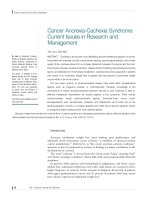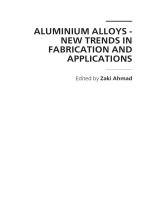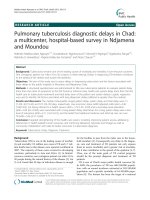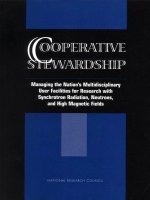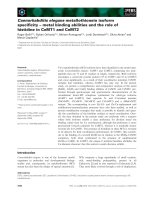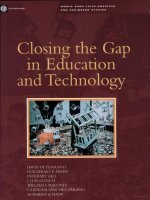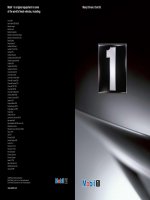Vital Assets - Federal Investment in Research and Development at the Nation’s Universities and Colleges potx
Bạn đang xem bản rút gọn của tài liệu. Xem và tải ngay bản đầy đủ của tài liệu tại đây (2.14 MB, 189 trang )
Vital
Assets
Federal Investment
in Research and
Development at the
Nation’s Universities
and Colleges
Donna Fossum
Lawrence S. Painter
Elisa Eiseman
Emile Ettedgui
David M. Adamson
The Federal Research and Development Portfolio
Supported by the
National Science Foundation
R
Science and Technology
The RAND Corporation is a nonprofit research organization providing objective analysis
and effective solutions that address the challenges facing the public and private sectors
around the world. RAND’s publications do not necessarily reflect the opinions of its research
clients and sponsors.
R
®
is a registered trademark.
© Copyright 2004 RAND Corporation
All rights reserved. No part of this book may be reproduced in any form by any electronic or
mechanical means (including photocopying, recording, or information storage and retrieval)
without permission in writing from RAND.
Published 2004 by the RAND Corporation
1700 Main Street, P.O. Box 2138, Santa Monica, CA 90407-2138
1200 South Hayes Street, Arlington, VA 22202-5050
201 North Craig Street, Suite 202, Pittsburgh, PA 15213-1516
RAND URL: />To order RAND documents or to obtain additional information, contact
Distribution Services: Telephone: (310) 451-7002;
Fax: (310) 451-6915; Email:
The research described in this report was conducted by the Science and Technology Policy
Institute (operated by RAND from 1992 to November 2003) for the National Science
Foundation, under contract ENG-9812731.
Library of Congress Cataloging-in-Publication Data
Vital assets : federal investment in research and development at the nation’s universities and colleges /
Donna Fossum [et al.].
p. cm.
“MR-1824.”
ISBN 0-8330-3624-6 (pbk.)
1. Federal aid to research—United States. 2. Universities and colleges—Research—United States—Finance.
I. Fossum, Donna, 1949–
Q180.U5V57 2004
338.973'06—dc22
2004005269
iii
PREFACE
About This Analysis
The federal government’s investment in the research and development (R&D) being
conducted at the nation’s universities and colleges has grown considerably in recent
years and represents a pivotal part of the U.S. innovation system—one that advances
knowledge of the world and provides critical training to the next generation of scien-
tists and engineers.
The analysis in this report assesses that investment. The analysis drew on the RAND
Corporation’s RaDiUS (Research and Development in the United States) database
and was designed to provide an empirical basis for assessing the federal investment
in university-based R&D. It builds on work described in Discovery and Innovation:
Federal Research and Development Activities in the Fifty States, District of Columbia,
and Puerto Rico (Fossum et al., 2000). That earlier work, which also drew on the
RaDiUS database, created profiles of federal R&D spending and programs for each
state and the two territories. Each profile also provided a brief look at the federal
R&D funds going to the state or territory’s universities and colleges. Subsequent
requests for more detailed information on this topic ultimately led to the current
report.
Information on federal R&D funds that are going to the nation’s universities and col-
leges can vary considerably depending on the source of the information and how it
was collected. The data presented in this report are drawn from official transactional
records of the U.S. government rather than from surveys, so the accounting of which
universities and colleges received federal funds for the conduct of R&D—as this term
is defined by the federal government—in a single fiscal year is more complete and
accurate. The results are presented both by state, including the District of Columbia
and Puerto Rico, and by individual university and college. Such data have a variety of
potential uses, from gauging the competitive status of specific institutions of higher
education to underpinning the planning of regional economic development.
iv Vital Assets: Federal Investment in R&D at the Nation’s Universities and Colleges
About the Office of Science and Technology Policy
The Office of Science and Technology Policy (OSTP) was created in 1976 to provide
the President of the United States with timely policy advice and to coordinate the
federal investment in science and technology.
About the Science and Technology Policy Institute
Originally created by Congress in 1991 as the Critical Technologies Institute and re-
named in 1998, the Science and Technology Policy Institute (S&TPI) is a federally
funded research and development center (FFRDC). It is sponsored by the National
Science Foundation and was managed by the RAND Corporation from 1992 through
November 30, 2003.
The S&TPI’s mission is to help improve public policy by conducting objective, inde-
pendent research and analysis on policy issues that involve science and technology.
To this end, the institute
• Supports the Office of Science and Technology Policy and other Executive
Branch agencies, offices, and councils;
• Helps science and technology decisionmakers understand the likely conse-
quences of their decisions and choose among alternative policies; and
• Helps improve understanding in both the public and the private sector of the
ways in which science and technology can better serve national objectives.
In carrying out its mission, the S&TPI consults broadly with representatives from pri-
vate industry, institutions of higher education, and other nonprofit institutions.
Inquiries regarding the S&TPI may be directed to the address below.
Stephen Rattien
Director
RAND Science and Technology
1200 South Hayes Street
Arlington, VA 22202-5050
Tel: 703.413.1100, ext. 5219
Web: www.rand.org/scitech
v
CONTENTS
Preface iii
Figures vii
Tables ix
Summary xi
Acknowledgments xv
Glossary xvii
Chapter One
INTRODUCTION 1
Background 1
Purpose of This Report 3
Methodology and Approach 3
How This Report Is Organized 5
Chapter Two
FEDERAL R&D FUNDS TO UNIVERSITIES AND COLLEGES 7
Overall Trends 7
The Role of Medical Schools 12
How R&D Support Varies by Federal Agency 12
A Level Playing Field 18
R&D Specialization and Its Consequences 21
How Federal R&D Funds Are Conveyed 21
Which Institutions Compete for Federal R&D Funds? 27
Individual Universities and Colleges: How Do They Compare in
Obtaining Federal R&D Funds? 29
Other Cuts Through the Data 38
Chapter Three
CONCLUSIONS AND IMPLICATIONS 41
Conclusions 41
Implications for Federal R&D Priorities 41
Implications for Decisionmaking 42
Other Implications 42
vi Vital Assets: Federal Investment in R&D at the Nation’s Universities and Colleges
Appendix
A. The RaDiUS Database 45
B. Methodology 49
C. Additional Tables 53
D. Sources of Data 55
References 59
vii
FIGURES
2.1. Total Funding in Current Dollars for Conduct of R&D in
FY 1996–2002, by Federal Agency 8
2.2. Total Funding in Constant 1996 Dollars for Conduct of R&D in
FY 1996–2002, by Federal Agency 8
2.3. Funds Provided by Federal Agencies to Universities and Colleges
for Conduct of R&D in FY 2002 14
2.4. Agencies Providing Federal Funds to Universities and Colleges
for Conduct of R&D in FY 2002 18
ix
TABLES
2.1. Federal Funds in Current Dollars Provided to Universities and
Colleges, Including Medical Schools, for Conduct of R&D in FY
1996–2002, by State in Rank Order 9
2.2. Federal Funds in Constant 1996 Dollars Provided to Universities
and Colleges, Including Medical Schools, for Conduct of R&D in
FY 1996–2002, by State in Rank Order 10
2.3. States Ranked According to Total Federal Funds Received for
Conduct of R&D in FY 2002 by Their Resident Universities and
Colleges, Including and Excluding Medical Schools 13
2.4. Agencies Providing Federal Funds to Universities and Colleges,
Including Medical Schools, for Conduct of R&D in FY 2002, by
State 16
2.5. Agencies Providing Federal Funds to Universities and Colleges,
Excluding Medical Schools, for Conduct of R&D in FY 2002, by
State in Rank Order 19
2.6. Agencies Providing the First, Second, and Third Most Federal
Funds to Universities and Colleges, Excluding Medical Schools,
for Conduct of R&D in FY 2002, by State 22
2.7. Federal Funds Provided to Universities and Colleges, Including
Medical Schools, for Conduct of R&D in FY 2002 , by State in
Rank Order 24
2.8. Federal Funds Provided to Universities and Colleges, Excluding
Medical Schools, for Conduct of R&D in FY 2002, by State in Rank
Order 26
2.9. Percentage of Universities and Colleges Receiving Federal Funds
for Conduct of R&D in FY 2002, by State and by Types of Degrees
Granted by the Universities and Colleges Located in the State 28
2.10. Federal Funds Provided to Top 100 Universities and Colleges for
Conduct of R&D in FY 2002 30
2.11. Federal Funds Provided to Medical Schools for Conduct of R&D
in FY 2002, by Medical School in Rank Order 35
xi
SUMMARY
BACKGROUND AND PURPOSE
Universities and colleges conduct a substantial portion of America’s scientific re-
search. Much of this research is funded by federal research and development (R&D)
dollars. Federal R&D funds help universities advance general knowledge, support a
range of federal missions, train future scientists and engineers, and enhance eco-
nomic growth in the communities where they operate. Despite the importance of
these activities, decisionmakers face difficulty assessing and monitoring the size of
this federal R&D investment and its changing profile over time. This difficulty is
rooted in a lack of access to accurate, timely, consistent, and comprehensive infor-
mation about federal funds going to university and college R&D. As a result, funding
allocations and policy decisions are often made without adequate information.
This report is intended to provide an empirical basis for assessing the federal invest-
ment in university-based R&D. To do this, RAND compiled a comprehensive list of
all the federal R&D funds going to every university and college in the 50 states, the
District of Columbia, and Puerto Rico (hereafter referred to collectively as “the
states”). The analysis used RAND’s RaDiUS (Research and Development in the
United States) database of federal R&D funding and activities. This report presents
the results of the analysis. Specifically, it provides information on
• State-by-state trends in federal funding of R&D at U.S. universities and colleges
from FY 1996 through FY 2002,
• Which federal agencies provided what amounts and types of R&D funds to uni-
versities and colleges in FY 2002, and
• What levels of R&D funding individual universities and colleges received in FY
2002.
This report is intended as a reference document for national, regional, state, and uni-
versity decisionmakers and planners interested in assessing the relative competitive-
ness of particular university systems and individual campuses in obtaining federal
R&D funds. It is also intended to stimulate and enable further analysis and assess-
ment of trends, priorities, and resource allocations involving federally funded R&D.
xii Vital Assets: Federal Investment in R&D at the Nation’s Universities and Colleges
METHODOLOGY AND APPROACH
The data presented in this report come from the RaDiUS database. RaDiUS systemat-
ically tracks all federal R&D funds by tracing them from their most aggregate level in
the federal government, at which the R&D activities are planned in general, to their
most detailed level, at which the R&D is actually conducted. The most-aggregated
data presented are for FY 1996 through FY 2002. The most-detailed data are from FY
2002, since this is the most recent fiscal year for which such data are available. For
that year, we also identified all individual R&D awards that went to the 126 accred-
ited medical schools located within the nation’s universities and colleges. For addi-
tional details on the methodology of this analysis, see Appendix B.
CONCLUSIONS AND IMPLICATIONS
The data show that between FY 1996 and FY 2002, total federal R&D funds going to
universities and colleges grew from $12.8 billion to $21.4 billion, for an overall in-
crease of 45.7 percent in constant 1996 dollars. The level of increase in federal R&D
funds going to universities and colleges between FY 1996 and FY 2002 was more than
double the overall increase in total federal R&D funds during the same period in con-
stant 1996 dollars (i.e., 45.7 percent versus 20.9 percent).
Much of this growth was attributable to sizable increases in R&D funding at the
Department of Health and Human Services (HHS), most especially the National
Institutes of Health. The main recipients of HHS’s funds were nonfederal entities,
primarily universities and colleges. By far the most striking finding of this analysis
was the discovery that, in FY 2002, 45 percent of all federal R&D funds provided to
universities and colleges by HHS and all other federal agencies went directly to
medical schools. Because some states do not have medical schools and others have
many, this pattern skews the distribution of federal R&D funds among the various
states considerably.
Implications for Federal R&D Priorities
The profile of federally funded R&D at universities and colleges that emerges from
this analysis raises issues of proportionality. Specifically, in the current funding pro-
file, approximately two-thirds of the federal funds going to universities and colleges
for the conduct of R&D is focused on only one field of science—life science—and
federal R&D funding is concentrated at only a few research universities. These find-
ings raise questions about whether other critical national needs that have substantial
R&D components (such as environment, energy, homeland security, and education)
are receiving the investment they require and whether the concentration of dollars at
a few institutions is shortchanging science students at institutions that receive little
or no federal R&D funding.
Summary xiii
Implications for Decisionmaking
This analysis provides information that should help clarify several issues for univer-
sity and college decisionmakers as well as federal agencies.
First, universities and colleges have lacked long-term, consistent data with which to
gauge their success at acquiring R&D funding. In the absence of such data, credible
comparisons among institutions cannot be made. This analysis enables all universi-
ties and colleges with R&D activity to know where they stand relative to other insti-
tutions in their ability to obtain federal R&D funds.
Second, the vehicle used to convey federal R&D funds to universities and colleges
(i.e., grant versus contract) is important because it establishes the legal “ground
rules” for conducting federally funded R&D. This analysis disproves the persistent
stereotype that all federal R&D funds are conveyed to universities and colleges via
peer-reviewed project grants. As a result, all universities and colleges now have accu-
rate information on the funding mechanisms the federal government has actually
used to transmit R&D funds to them, so they can better assess intellectual property
issues arising from such R&D.
Third, using the data in this report, federal R&D agencies can now specifically target
the universities and colleges in the nation that truly need federal assistance to build
their R&D capacity.
xv
ACKNOWLEDGMENTS
The authors wish to thank the many people who encouraged us to expand our
summary presentation of information on the federal R&D funding going to higher
education institutions that was presented in Discovery and Innovation: Federal
Research and Development Activities in the Fifty States, District of Columbia, and
Puerto Rico. In particular, the authors wish to thank Michael E. Davey, Specialist in
Science and Technology in the Resources, Science, and Industry Division of the
Congressional Research Services, for his insights and advice throughout the
preparation of this report, and his willingness to review the drafts of this report.
RAND peer reviewer John Adams has also been of great help with this project, as
have their other RAND colleagues: Scott Florence, Aaron Kofner, Lisa Sheldone,
Connie S. Moreno, Phyllis Gilmore, Stephen Bloodsworth, and Robin Cole.
xvii
GLOSSARY
Affiliated Research Institute—A nonprofit, independently operated research organi-
zation that is very closely affiliated with a particular university or college. These re-
search organizations share research facilities and/or faculty/staff with a university or
college. See Table C.23 in Appendix C for a list of affiliated research institutes.
Agency—A department, agency, or instrumentality of the U.S. government (see 31
USC 101). The federal agencies featured in this report include the Department of
Defense (DOD), the Department of Health and Human Services (HHS), the Depart-
ment of Energy (DOE), the Department of Agriculture (USDA), the National Aero-
nautics and Space Administration (NASA), and the National Science Foundation
(NSF), which collectively controlled 95 percent of all federal funds devoted to the
conduct of R&D in FY 2002.
Applied Research—Systematic study to gain knowledge or understanding necessary
to determine the means of a recognized and specific need (see OMB Circular A-11,
Section 84). See Conduct of Research and Development.
Award—A contract, grant, cooperative agreement, or other legal instrument a federal
agency uses to engage the services of a nongovernmental entity to carry out a gov-
ernmental responsibility or to achieve some purpose.
Basic Research—Systematic study directed toward fuller knowledge or understand-
ing of the fundamental aspects of phenomena and of observable facts without spe-
cific applications toward processes or products in mind (see OMB Circular A-11,
Section 84). See Conduct of Research and Development.
Baseline—All funds reported to the Office of Management and Budget (OMB) as
being spent on activities that meet the OMB definition of what constitutes R&D and
which therefore fall within the federal R&D portfolio.
Budget Authority—Authority provided by law to incur (i.e., enter into) financial obli-
gations that will result in immediate or future outlays of federal government funds
(see Budget of the United States Government, Analytical Perspectives, Fiscal Year
2002; and see OMB Circular A-11, Section 20).
College—A postsecondary school that offers general or liberal arts education, usually
leading to an associate, bachelor’s, master’s, doctor’s, or first professional degree.
Although this term usually encompasses junior colleges and community colleges,
xviii Vital Assets: Federal Investment in R&D at the Nation’s Universities and Colleges
this report does not include junior colleges, community colleges, technical schools,
or schools granting only associate degrees (see National Center for Education Statis-
tics, “Digest of Education Statistics, 2002,” June 2003). See University.
Conduct of Research and Development—Systematic creative work undertaken to
increase the stock of knowledge, including knowledge of man, culture, and society,
and the use of this stock of knowledge to devise new applications. Includes Basic Re-
search, Applied Research, and Development and the administrative expenses associ-
ated with each. Excludes research and development facilities and equipment. Also
excludes routine product testing, quality control, mapping, collection of general-
purpose statistics, experimental production, routine monitoring and evaluation of an
operational program, and the training of scientific and technical personnel (see OMB
Circular A-11, Section 84). See Basic Research, Applied Research, and Development.
Contract—A legal instrument reflecting a relationship between the U.S. government
and a state, local government, or other recipient (1) when the principal purpose of
the instrument is to acquire (by purchase, lease, or barter) property or services for
the direct benefit or use of the U.S. government or (2) when the agency decides in a
specific instance that the use of a procurement contract is appropriate (see 31 USC
6303).
Cooperative Agreement—A legal instrument reflecting a relationship between the
U.S. government and a state, local government, or other recipient (1) when the prin-
cipal purpose of the relationship is to transfer a thing of value to the state, local gov-
ernment, or other recipient to carry out a public purpose of support or stimulation
authorized by a law of the United States instead of acquiring (by purchase, lease, or
barter) property or services for the direct benefit or use of the U.S. government and
(2) when substantial involvement is expected between the executive agency and the
state, local government, or other recipient when carrying out the activity contem-
plated in the agreement (see 31 USC 6305). Does not include cooperative research
and development agreements. See Cooperative Research and Development Agree-
ment.
Cooperative Research and Development Agreement (CRADA)—Any agreement
between one or more federal laboratories and one or more nonfederal parties under
which the government, through its laboratories, provides personnel, services, facili-
ties, equipment, intellectual property, or other resources with or without reim-
bursement (but not funds to nonfederal parties) and the nonfederal parties provide
funds, personnel, services, facilities, equipment, intellectual property, or other re-
sources toward the conduct of specified research or development efforts which are
consistent with the missions of the laboratory; except that such term does not in-
clude a procurement contract or cooperative agreement as those terms are used in
sections 6303, 6304, and 6305 of Title 31 (see 15 USC 3710a). NOTE: This report does
not provide information on CRADAs, and we provide this definition solely to enable
readers to understand the differences between CRADAs and cooperative agreements.
Development—The systematic application of knowledge or understanding, directed
toward the production of useful materials, devices, and systems or methods, includ-
ing design, development, and improvement of prototypes and new processes to meet
Glossary xix
specific requirements (see OMB Circular A-11, Section 84). See Conduct of Research
and Development.
Discretionary Spending—Budgetary resources provided in appropriation acts, ex-
cept those provided to fund mandatory spending programs (i.e., entitlements and
food stamps) (see OMB Circular A-11, Section 20).
Enrollment—The total number of students registered in a given school unit at a
given time, generally in the fall of a year (see U.S. Department of Education, National
Center for Education Statistics, “Digest of Education Statistics, 2002,” June 2003).
Experimental Program to Stimulate Competitive Research (EPSCoR)—A program
Congress established in 1978 and placed under the auspices of the National Science
Foundation (NSF) to assist states that have historically received fewer federal R&D
funds. The objective is to increase the ability of academic institutions in these states
to compete for such funds and thereby to develop the science and technology re-
sources in the states that support the creation of economic opportunities (i.e., busi-
nesses and jobs) for their citizens. To participate in EPSCoR, states must be willing to
provide at least partial funding for all approved projects so that the endeavor is a true
partnership with the federal government. In 2002, 22 states (Alabama, Alaska,
Arkansas, Delaware, Hawaii, Idaho, Kansas, Kentucky, Louisiana, Maine, Mississippi,
Montana, Nebraska, Nevada, New Mexico, North Dakota, Oklahoma, South Carolina,
South Dakota, Vermont, West Virginia, and Wyoming), the Commonwealth of Puerto
Rico, and the U.S. Virgin Islands participated in NSF’s EPSCoR program. (Note that
the U.S. Virgin Islands was not in the earlier analysis, reported on in Discovery and
Innovation: Federal Research and Development Activities in the Fifty States, District of
Columbia, and Puerto Rico, MR-1194-OSTP/NSF, RAND Corporation, 2000, and
therefore is not included in this report.) In 2003, Delaware and Tennessee also joined
the program. Also note that, in recent years, other federal agencies (i.e., DOD, DOE,
USDA, HHS, NASA, and EPA) have begun similar programs based on the EPSCoR
concept.
Expenditure—“A disbursement of funds” (Merriam Webster’s Collegiate Dictionary,
10th ed., 1993). NSF defines expenditures as “funds actually spent by an institution
during its fiscal year” (National Science Foundation, Division of Science Resources
Statistics, “Academic Research and Development Expenditures: Fiscal Year 2001,”
Arlington, VA [NSF 03-316], April 2003). See Outlay.
Faculty—Members of the instruction and/or research staff who are employed full or
part time, as defined by the institution (see U.S. Department of Education, National
Center for Education Statistics, “Digest of Education Statistics, 2002,” June 2003).
Federally Funded Research and Development Center (FFRDC)—An FFRDC meets
some special long-term research or development need that cannot be met as effec-
tively by existing in-house or contractor resources. FFRDCs enable agencies to use
private-sector resources to accomplish tasks that are integral to the mission and op-
eration of the sponsoring agency. To discharge its responsibilities to the sponsoring
agency, an FFRDC has access, beyond what is common in a normal contractual rela-
tionship, to government and supplier data, including sensitive and proprietary data,
xx Vital Assets: Federal Investment in R&D at the Nation’s Universities and Colleges
and to employees and facilities. An FFRDC is required to conduct its business in a
manner befitting its special relationship with the government, to operate in the pub-
lic interest with objectivity and independence, to be free from organizational con-
flicts of interest, and to have full disclosure of its affairs to the sponsoring agency. It is
not the government’s intent that an FFRDC use its privileged information or access
to facilities to compete with the private sector. However, an FFRDC may perform
work other than that for the sponsoring agency under the Economy Act, or other
applicable legislation, when the work is not otherwise available from the private sec-
tor. Each of the 36 FFRDCs the federal government currently sponsors is adminis-
tered (i.e., operated) by an industrial firm, university, or nonprofit institution (see
Federal Acquisition Regulations [FAR] 35.017).
First Professional Degree Student—A student pursuing an award that requires com-
pletion of a program that meets all the following criteria:
• The academic requirements must be completed to begin practice in the profes-
sion,
• At least two years of college work must be completed before entering the pro-
gram, and
• Program completion requires a total of at least six academic years of college
work, including both prior required college work and the length of the profes-
sional program itself.
First professional degrees may be awarded in the following ten fields: chiropractic
(DC or DCM), osteopathic medicine (DO), dentistry (DDS or DMD), pharmacy
(PharmD), law (LLB or JD), podiatry (DPM, DP, or PodD), medicine (MD), theology
(MDiv, MHL, BD, or Ordination), optometry (OD), and veterinary medicine (DVM)
(see U.S. Department of Education, National Center for Education Statistics, Inte-
grated Postsecondary Education Data System [IPEDS], Fall 2000). Does not include
graduate students. See Graduate Student.
Fiscal Year—The federal government’s accounting period. It begins on October 1
and ends on September 30 and is designated by the calendar year in which it ends
(see OMB Circular A-11, Section 20).
Formula Grant—Allocation of money to states or their subdivisions according to a
formula prescribed by law or administrative regulation, for continuing activities that
are not confined to a specific project (see Catalog of Federal Domestic Assistance,
GSA, 2002). See Grant. Note that, for the purposes of this report, all grants awarded
under Catalog of Federal Domestic Assistance (CFDA) Program 10.216 were treated
as formula grants instead of project grants because only 18 institutions of higher
education in the nation were eligible to receive federal R&D grant funds under this
program, and these were the same 18 institutions that received substantially larger
formula grants each year under the closely related CFDA Program 10.205.
Graduate Student—A student who holds a bachelor’s or first professional degree, or
the equivalent, and who is working toward a master’s or doctor’s degree. Does not
include first professional degree students (U.S. Department of Education, National
Glossary xxi
Center for Education Statistics, “Digest of Education Statistics, 2002,” June 2003). See
First Professional Degree Student.
Grant—A legal instrument reflecting a relationship between the U.S. government
and a state, local government, or other recipient (1) when the principal purpose of
the relationship is to transfer a thing of value to the state or local government or
other recipient to carry out a public purpose of support or stimulation authorized by
a law of the United States instead of acquiring (by purchase, lease, or barter) property
or services for the direct benefit or use of the U.S. government and (2) when substan-
tial involvement is not expected between the executive agency and the state, local
government, or other recipient when carrying out the activity contemplated in the
agreement (see 31 USC 6304). See Project Grant and Formula Grant.
Historically Black College or University (HBCU)—An accredited institution of higher
education established prior to 1964 with the principal mission of educating black
Americans. The Higher Education Act of 1965, as amended, defines an HBCU as “any
historically black college or university that was established prior to 1964, whose
principal mission was, and is, the education of black Americans. . . .” Federal regula-
tions (see 20 USC 1061[2]) allow certain exceptions to the founding date (U.S. De-
partment of Education, National Center for Education Statistics, “Digest of Educa-
tion Statistics, 2002,” June 2003).
Land-Grant University (includes 1890 Schools)—Established by the passage of the
first Morrill Act of 1862, which facilitated the establishment of colleges through
grants of land or of funds in lieu of land. The Morrill Act was intended to provide a
broad segment of the population with a practical education that had direct relevance
to their daily lives. 1890 Land-Grant Colleges and Universities and Tuskegee Uni-
versity are historically black land-grant colleges and universities (HBCUs) estab-
lished through the Second Morrill Act of August 30, 1890, which expanded the system
of land-grant universities to include historically black institutions in states in which
segregation denied minorities access to the land-grant institution established by the
First Morrill Act, in 1862. Through the Second Morrill Act and several other authori-
ties, these institutions may receive federal funds for agricultural research, extension,
and teaching (see United States Department of Agriculture Cooperative State Re-
search, Education, and Extension Service Acronyms and Commonly Used Terms,
2003).
Medical School (note that this term excludes osteopathic, chiropractic, and podiatry
schools when used in this report)—An institution offering a program of medical edu-
cation leading to the MD degree. Virtually all state licensing boards require that U.S.
medical schools be accredited by the Liaison Committee on Medical Education
(LCME) as a condition for licensing their graduates to practice medicine within a
state. Currently, the LCME accredits 126 programs at universities and colleges within
the United States, all of which lead to the MD degree (see Liaison Committee on
Medical Education, Directory of Accredited Medical Education Programs, available
at as of March 3, 2004). Note that the term medi-
cal school, as used in this report, does not encompass hospitals or medical centers
(i.e., so-called “teaching” hospitals) that are in some way “affiliated with” or
xxii Vital Assets: Federal Investment in R&D at the Nation’s Universities and Colleges
“connected to” a university or college and/or its “medical school.” Instead, the term
refers only to the 126 programs within universities and colleges that provide medical
education leading to the MD degree.
Obligations—Binding agreements that will result in outlays (see Outlay) immediately
or in the future. That is, the amounts of orders placed, contracts awarded, services
received, and similar transactions during a given period that will require payments
during the same or a future period. Budgetary resources must be available before
obligations can be incurred legally (see Budget of the United States Government,
Analytical Perspectives, Fiscal Years 2002; OMB Circular A-11, Section 20).
Outlay—A payment to liquidate an obligation (other than the repayment of debt
principal). Outlays are generally equal to cash disbursements, and they are the mea-
sure of government spending (see Budget of the United States Government, Analyti-
cal Perspectives, Fiscal Years 2002; OMB Circular A-11, Section 20). See Expenditure.
Private University or College—A university or college that is controlled by an indi-
vidual or agency other than a state, a subdivision of a state, or the federal govern-
ment and that is usually supported primarily by other than public funds, and the
operation of whose program rests with other than publicly elected or appointed offi-
cials. Private schools and institutions include both nonprofit and proprietary institu-
tions (see U.S. Department of Education, National Center for Education Statistics,
“Digest of Education Statistics, 2002,” June 2003).
Project Grant—The funding, for fixed or known periods, of specific projects for the
delivery of specific services or products without liability for damages for failure to
perform (see Catalog of Federal Domestic Assistance, GSA, 2002). See Grant.
Public University or College—A university or college controlled and operated by
publicly elected or appointed officials and deriving its primary support from public
funds (see U.S. Department of Education, National Center for Education Statistics,
“Digest of Education Statistics, 2002,” June 2003).
Research and Development (R&D)—Throughout this report, this term refers only to
the Conduct of Research and Development, as defined above.
Research and Development Equipment—The acquisition or design and production
of major equipment for R&D. Includes expendable or movable equipment (e.g.,
spectrometers, research satellites, and detectors). Excludes routine purchases of or-
dinary office equipment or furniture and fixtures. (See OMB Circular A-11, Section
84.)
Research and Development Facilities—The construction and rehabilitation of R&D
facilities. Includes the acquisition, design, and construction of, or major repairs or
alterations to, all physical facilities for use in R&D activities. Facilities include land,
buildings, and fixed capital equipment, regardless of whether the facilities are to be
used by the government or by a private organization and regardless of where title to
the property may rest. The term also includes the International Space Station and
such fixed facilities as reactors, wind tunnels, and particle reactors, but excludes
movable R&D equipment. (See OMB Circular A-11, Section 84.)
Glossary xxiii
Science and Engineering—The disciplines in the fields of Engineering, Physical Sci-
ences, Mathematical Sciences, Computer Sciences, Life Sciences, Psychology, and
Social Sciences (see National Science Foundation, Division of Science Resources
Statistics, “Survey of Graduate Students and Postdoctorates in Science and Engineer-
ing: Fall 2000 [Methodology Report],” Arlington, VA , July 2002).
Undergraduate Student—A student registered at an institution of higher education
who is working in a program leading to a baccalaureate degree or other formal award
below the baccalaureate, such as an associate degree (see U.S. Department of Edu-
cation, National Center for Education Statistics, “Digest of Education Statistics,
2002,” June 2003).
University—An institution of higher education consisting of a liberal arts college, a
diverse graduate program, and usually two or more professional schools or faculties
and empowered to confer degrees in various fields of study (see U.S. Department of
Education, National Center for Education Statistics, “Digest of Education Statistics,
2002,” June 2003). See College.
1
Chapter One
INTRODUCTION
BACKGROUND
Innovation based on scientific and technological progress makes major contribu-
tions to U.S. economic prosperity, national security, and other national goals. The
system that supports such innovation consists of a complex network of institutions
that conduct research and development (R&D) in a range of settings, including uni-
versities, industry, and government. Because of the success of this system, it has been
accurately characterized as a vital national asset.
1
A hallmark of the U.S. innovation
system, as distinct from such systems in other industrialized nations, is its heavy re-
liance on universities and colleges to conduct federally funded R&D. In Japan and
Europe, for instance, specialized research institutes and government-operated labo-
ratories carry out a much higher fraction of federal R&D than such institutions do in
the United States,
2
where universities and colleges perform between 20 and 25 per-
cent of it. Since World War II, a steady infusion of federal R&D funds has helped
transform many U.S. universities into research-focused institutions. Indeed, in FY
2002, federal funds were paying for R&D being conducted at almost 800 of the
nation’s more than 1,825 university and college campuses.
Federal R&D funds contribute substantially to three important university functions.
First, they enable universities and colleges to sustain R&D programs in scientific and
engineering fields that might otherwise have difficulty securing financial support.
This R&D expands the collective knowledge of the world and, at the same time, helps
fulfill the basic missions of a number of federal agencies. Before World War II, the
major sources of funding for university R&D were state governments, industry, and
foundations. The federal entry into the funding of university R&D represented an
admission that these sources were not stable enough to grow and sustain this vital
component of the U.S. innovation system. In particular, it showed that the federal
government, unlike industry, was willing to support the conduct of long-term, high-
risk basic research at the nation’s universities and colleges.
Second, federally funded R&D supports the education and training of graduate stu-
dents in scientific and engineering fields, typically through research assistantships.
Thus, universities and colleges not only expand the knowledge base, they also edu-
______________
1
Popper and Wagner, 2002, p. ix.
2
Mowery and Rosenberg, 1993, p. 48.

